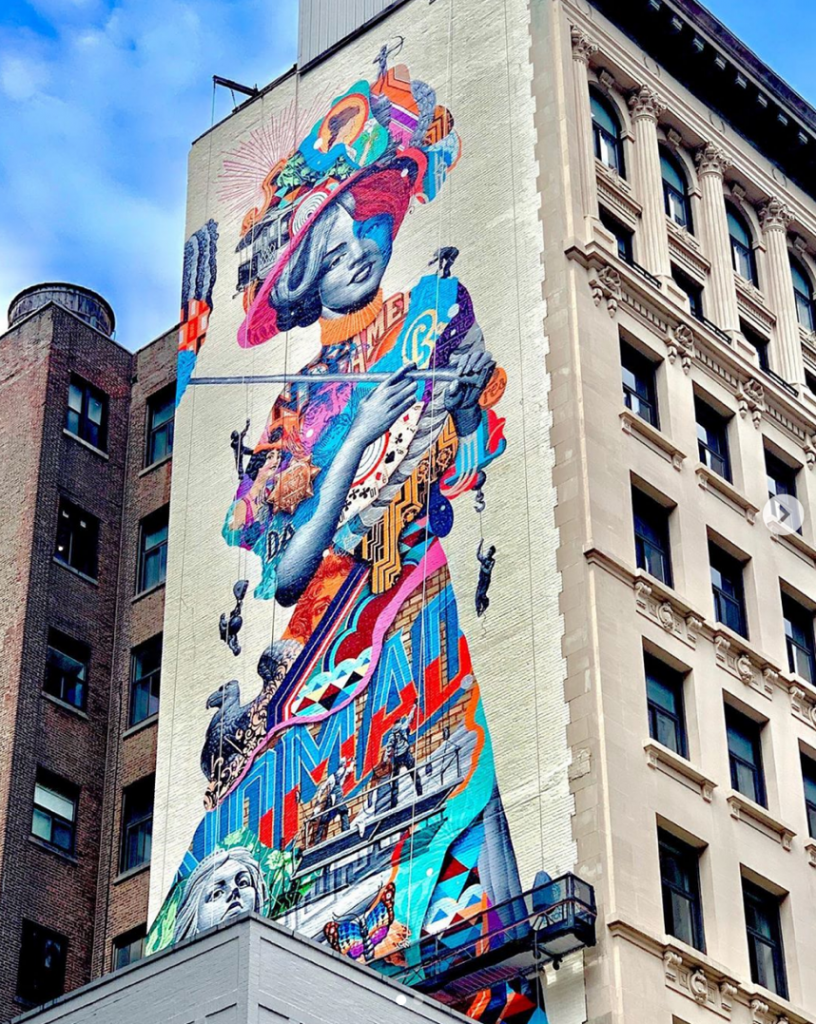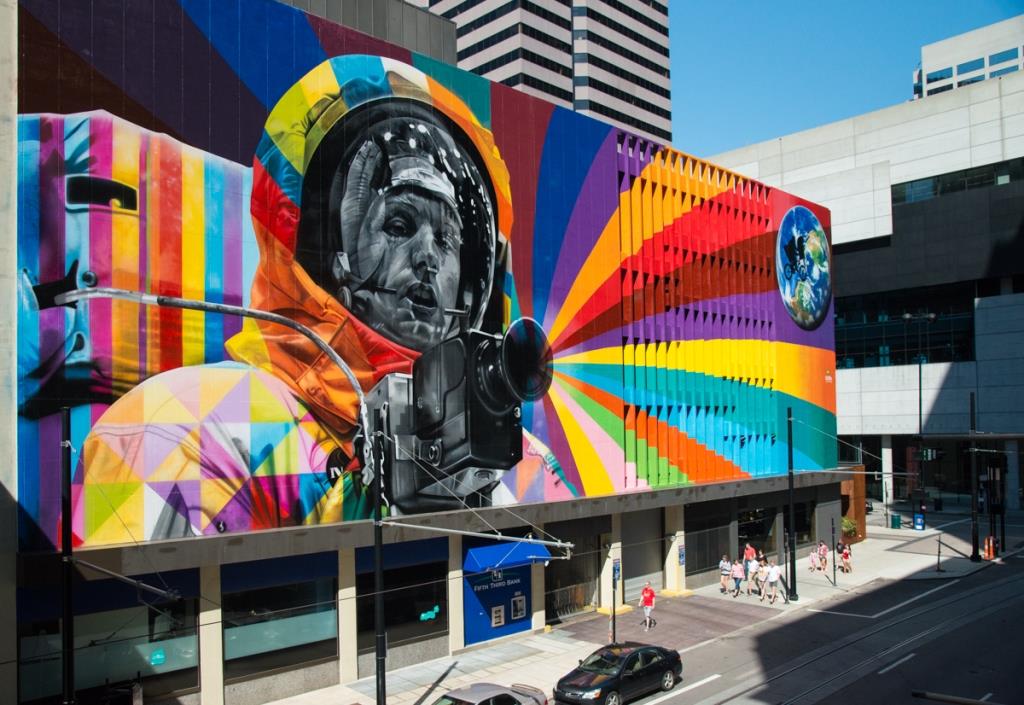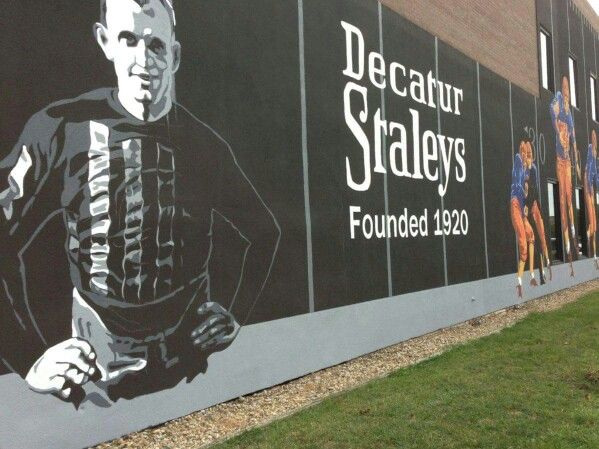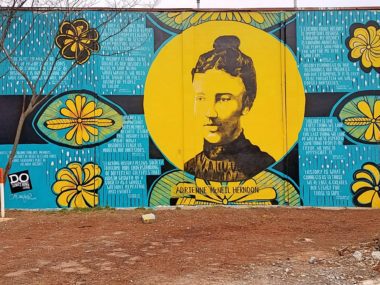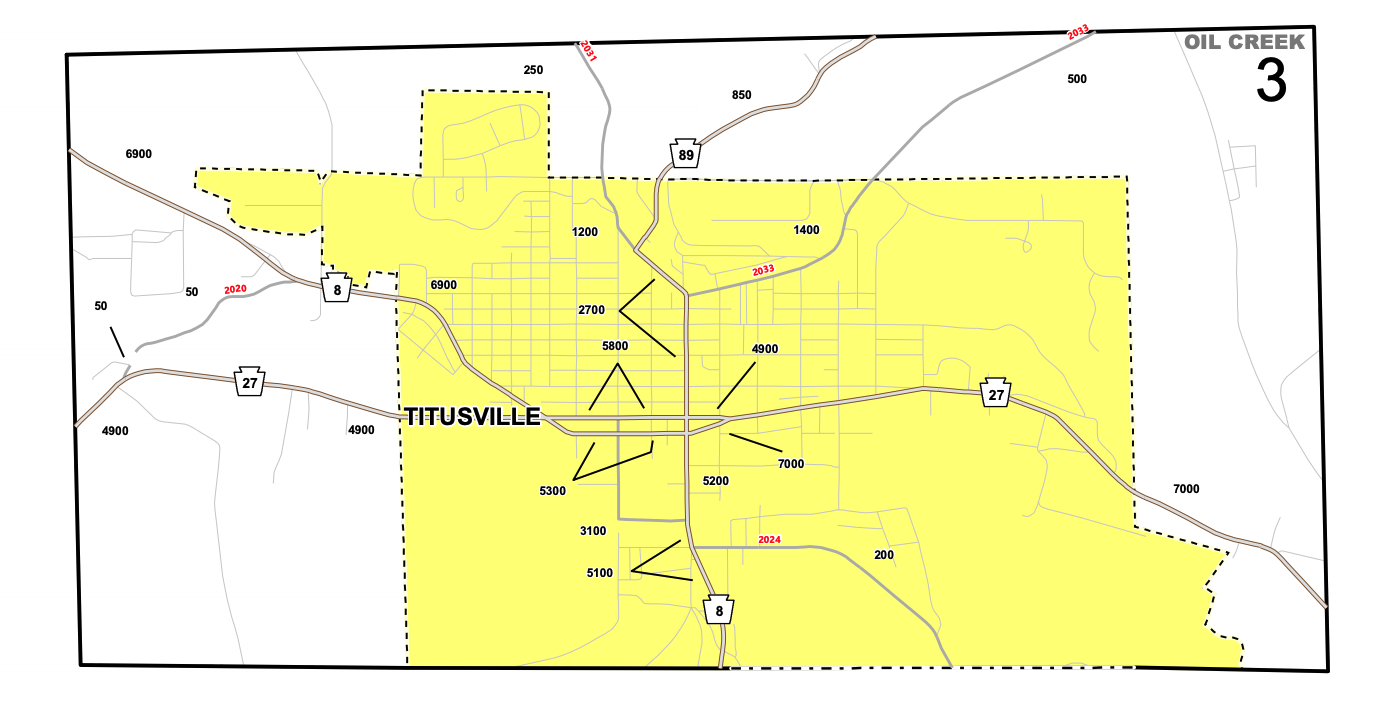Public Art
Art as Information
Introduction
Why shouldn’t Titusville be the valley that CONTINUES to change the world?
If someone was blindfolded and dropped into Titusville would they know where they are or would it look just like any other community?
Public art can do incredible things and tell you a lot about a community. It can tell a story, be a guide, define a space, and encourage engagement. It can build community, improve public perception and create spaces that beg to be explored.
Many communities struggle to be known for something. Titusville does not share that problem. With such a rich and significant history, it has many truly unique assets and amenities that are still a huge draw for the region.
One effect of such historic importance is feeling solely defined by your past. As indicated through the public visioning, many residents felt the community was looking backwards and not forward.
Public art provides an opportunity for Titusville to tell its story and define itself, not only of the past, but who they are today, as well as where they want to be in the future.
A rich public art plan can help Titusville capitalize on these existing unique assets, elevate tourism, build community pride, combat blight and improve overall quality of life.
Public Art Plan Goals
- Telling the story
Celebrate past, define present, create a vision for the future - Art as information
Wayfinding & welcoming, define the space - Beautification
Create vibrant and inviting spaces
Temporary vacant storefront installations
Improving public perception - Public engagement
Planning and creation opportunities
Events – build community and leaders
Background
When asked in the public survey ‘what’s missing or needs improvement downtown?’ Arts and Cultural Amenities came in a strong second behind dining and beverage options and followed immediately by beautification efforts.
When asked how would they describe Titusville today, and how they hope to describe Titusville in the year 2030, the top responses included:
Today
- Lacking
- Potential
- Depressed
- Struggling
- Beautiful
- Community
In 2030
- Vibrant
- Thriving
- Beautiful
- Welcoming
- Friendly
- Destination Community
These are excellent and encouraging visions for how residents hope Titusville should look and feel in the next ten years. However, the current descriptions combined with the overall key finding challenges indicate some significant work is needed if Titusville is to become known as a vibrant, thriving, beautiful and welcoming destination community of choice.
Luckily, public art and wayfinding are not only a natural way to help achieve these visions, but they are also excellent strategies to combat the existing challenges. The way a community looks and feels is subconsciously a direct reflection of the quality of life.
Perception is everything. To change the way it feels, let’s change the way it looks.
Suggested Style
and Theme:
Vintage Modern
While you certainly don’t want all public art to be the same, having an overarching style and theme will provide continuity of the community’s brand.
We recommend a vintage mod style marrying the old with the new. Classic and timeless yet futuristic and innovative. This would allow for a nod to the past honoring innovators, creators, and change makers, while simultaneously looking toward the future.
The Valley that continues to change the world.
Implementation Ideas
A robust public art plan should be more than murals, however, they are a great place to start. There are countless ways art can activate a space including traditional or unexpected, professional or amateur, permanent or temporary. The following are some examples of concepts to consider:
- Murals on sides and backs of buildings, alleyways
- Sculptures or other 3D elements
- Sidewalks and crosswalks
- Planters, benches, tables, and chairs
- Unexpected – Utility boxes, sidewalk gates, garbage cans, telephone poles
- Empty storefront windows
- Signage (traditional and non-traditional)
Public Engagement
To kick off the initiative, build public awareness and buy in, we recommend the first installation to include a high public engagement strategy. The following are some ways to build public engagement opportunities:
- Select the location: once the committee has narrowed the priority locations to the top 2-3 have a city wide vote for which should be chosen as the inaugural piece.
- Subject / concept: Call for public input on the subject matter. Either leave it open ended or offer choices to vote on.
- Artist selection: Once the committee has narrowed the applications to the top 2-3 open for public input or voting.
- Call for artists: Ask the public to help share the Call for Artists opportunity
- Building owners: Have a space you would like to bring to life? Submit an application with photos, info, ideas, and any budget you are willing to contribute.
- Pick up a paintbrush: Make the first piece a group effort! Hire a professional artist to design the concept and paint the outlines. Then ask the public to fill in the spaces.
- Window painting: Call for local artists to help paint vacant storefront windows (with the owners permission of course). This is an excellent way to temporarily activate the downtown and distract from vacant spaces. Ideally this should be done before a large community event or in the spring to maximize the summer months when tourism is high.
- This could be a volunteer or paid gig, but at a minimum all materials should be covered. Artists can be amateurs, students or professionals and should submit ideas and once selected are matched with a building.
- Partner with the school:
- Work with a local art class or club of students who will lead a community mural from start to finish including design, creation, volunteer recruiting and marketing. This is a great real world experience opportunity and students can additionally earn volunteer hours and add to their portfolio.
- OR – Create an internship program where students are individually hired to design, create, recruit and market these efforts while beautifying their city and earning some cash.
Art as Information: Wayfinding
Wayfinding is an information system for how people get a sense of place and are able to navigate from location to location. This could be a variety of visual indicators such as landmarks, color systems, signage, landscaping, and public art.
In addition to increased public art, Titusville would benefit greatly from a comprehensive wayfinding strategy. Titusville is lucky to have multiple attractions drawing in visitors into the community on a regular basis.
Capturing the opportunity to help guide people seamlessly through your community is critical to economic growth. The goal is to make it easy and inviting for people to find their way to and from local attractions and amenities.
The problem is most wayfinding signage is unremarkable and therefore easy to miss, defeating the whole purpose.
Wayfinding created by professional artists and designers, compared to standard, uniform signage gives leverages the power of individuality and can allow your space to be both unique and functional for a positive user experience.
Style and Theme
People come to Titusville mostly for historic and recreational tourism, and the feeling of the wayfinding installations should compliment this experience. The style and theme should continue on with the vintage mod brand – classic and timeliness, retro and modern.
Titusville has an opportunity to create some truly unique and interesting spaces and experiences at the intersection of directional signage and public art. If executed well, eventually the public art itself could be a draw for visitors*.
*Don't underestimate the power of a great selfie spot!
An excellent example: Instant Gramification, The Yardhouse via 99% Invisible Podcast
Check it outLocations
Titusville has more than a few entry points which have positives such as easier access from a variety of locations and challenges when considering locations for signage and gateway entrance pieces.
On an average day, there are an estimated 12,850 vehicles per day driving through downtown Titusville according to the AADT* PennDOT 2020 Traffic Volume map for Crawford County.
If even 5% of those vehicles stopped and spent $20 locally that’s over $4.5 million per year into the local economy.
AADT is a basic measurement that indicates vehicle traffic load on a road segment. It measures how busy a road is and is a critical input parameter in many transportation planning applications as well as for fund allocation to transportation agencies.
What would make more people stop to or plan a return visit to further explore Titusville? An exciting and inviting invitation. Signage is not the time to be timid, the message needs to be clear: Titusville is not to be missed!
When thinking about locations it is important to consider how people enter and drive through the community as well as where are the major junctions for guiding to local amenities.
In addition to vehicles, there is tremendous opportunity to extend the wayfinding strategy along the Queen City Trail leading to Downtown. Building off of the mural painted in 2019 at the end of the trail, this is an excellent opportunity to tell the Titusville story, while highlighting local service and experience opportunities.
The following Google Map identifies points of interest and proposed locations for wayfinding signage. You can use your mouse to move around the map.
Examples and Resources
- Cincinnati Art Works: An excellent example of a public art plan with a similar style that does a beautiful job of honoring their heritage while still maintaining a modern, vibrant aesthetic. Pieces are bright, bold and professional.
- Pittsburgh Arts Council Mural Making 101 Guide
- Grove City, PA – Pointing the Way program, winner of Governor’s Award for the Arts, teaches at-risk youth how to make metal sculptures
- The Great Wall of Honesdale, PA
- Muralist sought for Rail Trail Art Project
- Art on the Rail Trail
- Be Wowed by The Huge Murals in These Two Small Towns
- Putnam County, IN Mural Project – they even made the murals into free downloadable coloring books!
Funding
To fulfill this vision with high-quality installations, it will, of course, come with a price tag. But while funding is important, the most critical component is leadership. There are plenty of funding opportunities out there but without the right leaders who have the capacity and resources to devote to the implementation, the likelihood of these ideas coming to fruition is minimal.
Luckily, Titusville already has a number of local champions in arts and culture. Supporting, developing, and funding human and social capital will be the basis for this implementation strategy.
There are a number of different ways to model this but a few recommended ideas for consideration include:
- The city funds a contracted position dedicated to implementation, public engagement and/or grant writing for the Arts Commission. This could be housed within the city staff or with TCA to support the existing Executive Director. Options with TCA could be an additional staff member or to transform the ED position to full time in order to take on additional responsibilities of leading the Arts Commission.
- An internship program through the city focused on supporting the arts commission through various implementation tasks, public engagement and/or grant writing.
- PennSERVE / Americorps VISTA: The public art plan may be eligible for additional implementation support by hosting an Americorps member. There are a number of relevant examples of how this partnership could work, here are a few:
- Grant funding is available on a Federal (Competitive) and State (Formula) level.
Creative placemaking grants program
Project-based funding for arts, culture, and design activities that strengthen communities by advancing local economic, physical, and/or social outcomes.Requires a partnership between a local government entity and nonprofit organization.
Due Date: Possibly August, but the next round has not been announced
Amount: Cost share/matching grants range from $25,000 to $150,000, with a minimum cost share/match equal to the grant amount.
For more information, click here.
Offers support primarily to small organizations for projects in all artistic disciplines that extend the reach of the arts to populations that are underserved. Challenge America features an abbreviated application, a robust structure of technical assistance, and grants for a set amount of $10,000
Note: Grants.gov/SAM registrations due in March 30 and April 13
Due Date: April 27-May 4, 2021
Amount: Grants require a cost share/match of $10,000 consisting of cash and/or in-kind contributions. Total project costs must be at least $20,000 or greater.
For more information, click here.
Annual grants to the Department of Community and Economic Development (DCED) through the federal Department of Housing and Urban Development that are further allocated on a formula basis to approximately 200 local governments within Pennsylvania.
Housing rehabilitation, public services, community facilities, infrastructure improvement, development and planning. Must be used for activities that benefit low- and moderate-income persons, eliminate blight or meet an urgent need.
Public art projects could potentially qualify.
For more information, click here.
Resources may be available for historic art exhibits.
For more information, click here.
True Value Foundation provides 20 gallon paint grants through the Painting a Brighter Future program.
Note: Must include a youth development / leadership component to the project.
Due Date: March 31, 2021
Amount: 20-gallons of paint + materials
For more information, click here.
The COVID-19 Cultural and Museum Preservation Grant Program provides grants to cultural organizations and museums that experienced a loss of revenue from the closure by the proclamation of disaster emergency by the Governor on March 6, 2020.
Amount: $25,000 – $500,000
For more information, click here.
This Crawford County program aims to improve the quality of life for citizens through the preservation and enhancement of the county’s natural, scenic, and recreational resources for public use and enjoyment. This is a great resource for Wayfinding in Titusville!
For more information, click here.
The Redevelopment Assistance Capital Program (RACP) is a Commonwealth grant program administered by the Office of the Budget for the acquisition and construction of regional economic, cultural, civic, recreational, and historical improvement projects.
For more information, click here.
Action Steps: Public Art and Wayfinding
Who
The City of Titusville + TCA, Titusville Council on the Arts
How
The city should establish an Arts Commission to serve in an official advisory role to the council. Building off of existing leadership, the Titusville Council on the Arts should be the primary lead partner but would benefit from additional support considering the additional workload from the proposed concepts.
Members should ideally represent a diverse cross section of the community such as city leadership, business owners, non-profit leaders, artists, planners, students, philanthropists, and residents. Diversity in age, race, ethnicity, profession, length of local residency are all crucial for a truly well rounded perspective. This is a great opportunity to tap into new leadership – who might step up and be a champion?
The commission, with guidance from the city, should establish priority goals, locations, timeline and budgets. Review funding opportunities and apply for grants if needed. Build a list of favorite artists with a style that matches the envisioned outcome. Think big across the state and region as well.
Bonus: If possible, consider creating a youth or young professional art commission to develop the next generation of local leaders. Task this YP team to take the lead on one big project a year. Set the budget and parameters and let their creativity bloom with guidance along the way from the city and Arts Commission.
Who
The Titusville Arts Commission
How – Public Art
- Identify priority locations with high visibility, ideally at the gateway entrances to the downtown district. Reach out to building owners for interest and any match they are willing to contribute.
- Create and promote a Call for Artists and share it widely (use this as a guide: Sample Public Art RFP).
- Encourage favorite artists to apply.
- Review applications and select the artist whose style and budget best fits your vision for the space.
- Be sure to engage the public if possible. (see ideas above) Do not miss the opportunity for media coverage.
How – Wayfinding
- Create and promote a Request for proposals and share it widely. (Use as a starting point: Sample Wayfinding RFP)
- Reach out to preferred designers or firms with a style that matches the vision and/or previous experience working with the city and encourage them to apply.
- Review proposals and select a firm who will design a uniquely branded wayfinding strategy complimenting and continuing on the existing Titusville identity.
Who
The Titusville Arts Commission
How – Public Art
- Decide on continued public engagement opportunities if possible. Can the creation of this piece coincide with an existing public event?
- Make sure to announce the selection, process, opportunity to participate, and completion!
- Repeat! The commission should establish a number goal for installations per year on a depending on need and budget.
How – Wayfinding
- Work with the firm through the design process to select final concepts and locations. Build an implementation budget and work with local fabricators if possible for estimates.
- Depending on the design, materials and number of elements the budget can vary dramatically. Do not sacrifice quality and unique design for cheaper and easier. These will be an investment and they should be as unique and interesting as possible (not just another sign).
- If funding isn’t available for a fully executed strategy, build a scalable project timeline setting goals of __ number of signs or installations per year.
- Announce and celebrate designs and installations!
Creative placemaking grants program
Project-based funding for arts, culture, and design activities that strengthen communities by advancing local economic, physical, and/or social outcomes.Requires a partnership between a local government entity and nonprofit organization.
Due Date: Possibly August, but the next round has not been announced
Amount: Cost share/matching grants range from $25,000 to $150,000, with a minimum cost share/match equal to the grant amount.
For more information, click here.
Offers support primarily to small organizations for projects in all artistic disciplines that extend the reach of the arts to populations that are underserved. Challenge America features an abbreviated application, a robust structure of technical assistance, and grants for a set amount of $10,000
Note: Grants.gov/SAM registrations due in March 30 and April 13
Due Date: April 27-May 4, 2021
Amount: Grants require a cost share/match of $10,000 consisting of cash and/or in-kind contributions. Total project costs must be at least $20,000 or greater.
For more information, click here.
Annual grants to the Department of Community and Economic Development (DCED) through the federal Department of Housing and Urban Development that are further allocated on a formula basis to approximately 200 local governments within Pennsylvania.
Housing rehabilitation, public services, community facilities, infrastructure improvement, development and planning. Must be used for activities that benefit low- and moderate-income persons, eliminate blight or meet an urgent need.
Public art projects could potentially qualify.
For more information, click here.
Resources may be available for historic art exhibits.
For more information, click here.
True Value Foundation provides 20 gallon paint grants through the Painting a Brighter Future program.
Note: Must include a youth development / leadership component to the project.
Due Date: March 31, 2021
Amount: 20-gallons of paint + materials
For more information, click here.
The COVID-19 Cultural and Museum Preservation Grant Program provides grants to cultural organizations and museums that experienced a loss of revenue from the closure by the proclamation of disaster emergency by the Governor on March 6, 2020.
Amount: $25,000 – $500,000
For more information, click here.
